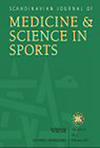Muscle Force Dynamics Across Increasing Squat Intensity Conditions in Elite Powerlifters
IF 3.5
2区 医学
Q1 SPORT SCIENCES
引用次数: 0
Abstract
The growing popularity of powerlifting, which consists of the squat, bench press, and deadlift, calls for biomechanically comprehensible coaching strategies. Understanding the muscle forces at work can play a key part in this endeavor. Therefore, the aim of this study was to investigate the effects of increasing intensity in the squat on muscle forces in elite powerlifters. Twenty‐nine top‐ranked powerlifters from the Austrian team (age: 26.1 ± 5.4 years; 1‐repetition‐maximum (1‐RM): 2.4 ± 0.4 × body mass) performed squats at 70%, 75%, 80%, 85%, and 90% of their 1‐RM. Force plates and 3D motion capture data were used to estimate muscle forces utilizing musculoskeletal models in OpenSim. Muscle forces significantly changed with increased intensity, particularly in the gluteus maximus and semitendinosus, which showed the greatest relative increase in muscle force. The vastii muscles exhibited the highest absolute muscle forces. Notably, the hamstrings, calf, and vastii muscle forces barely increased during the deepest and most challenging region of the squat (the sticking region) with increasing intensity. Furthermore, no correlation was found between the athletes' performance level and the ratio of single‐joint to multijoint hip extensor muscle forces. These findings highlight the importance of focusing on hip‐dominant techniques when squatting with high intensities and supplementary training for knee extensors to optimize performance.精英力量举重运动员在增加深蹲强度条件下的肌肉力量动态
力量举重(包括深蹲、卧推和硬举)越来越受欢迎,需要生物力学上易于理解的教练策略。了解工作中的肌肉力量可以在这一努力中发挥关键作用。因此,本研究的目的是调查提高深蹲强度对精英力量举重运动员肌肉力量的影响。来自奥地利队的29名顶级力量举重运动员(年龄:26.1±5.4岁;1‐重复-最大(1‐RM): 2.4±0.4 ×体重)在70%、75%、80%、85%和90%的1‐RM下进行深蹲。利用OpenSim中的肌肉骨骼模型,使用力板和3D运动捕捉数据来估计肌肉力。肌肉力量随着强度的增加而显著改变,尤其是臀大肌和半腱肌,其肌肉力量的相对增加最大。腹肌的绝对肌力最大。值得注意的是,在深蹲最深和最具挑战性的区域(粘着区域),腘绳肌、小腿肌和腹股肌的力量几乎没有随着强度的增加而增加。此外,运动员的表现水平与单关节与多关节髋关节伸肌力量的比例之间没有相关性。这些发现强调了在高强度深蹲和膝关节伸肌辅助训练时关注髋关节优势技术以优化表现的重要性。
本文章由计算机程序翻译,如有差异,请以英文原文为准。
求助全文
约1分钟内获得全文
求助全文
来源期刊
CiteScore
7.90
自引率
4.90%
发文量
162
审稿时长
3 months
期刊介绍:
The Scandinavian Journal of Medicine & Science in Sports is a multidisciplinary journal published 12 times per year under the auspices of the Scandinavian Foundation of Medicine and Science in Sports.
It aims to publish high quality and impactful articles in the fields of orthopaedics, rehabilitation and sports medicine, exercise physiology and biochemistry, biomechanics and motor control, health and disease relating to sport, exercise and physical activity, as well as on the social and behavioural aspects of sport and exercise.

 求助内容:
求助内容: 应助结果提醒方式:
应助结果提醒方式:


